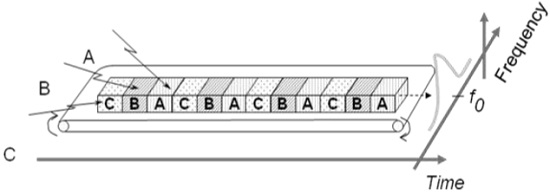Time Division Multiple Access (TDMA) is a digital cellular telephone communication technology. It facilitates many users to share the same frequency without interference. Its technology divides a signal into different timeslots, and increases the data carrying capacity.
TDMA Overview
Time Division Multiple Access (TDMA) is a complex technology, because it requires an accurate synchronization between the transmitter and the receiver. TDMA is used in digital mobile radio systems. The individual mobile stations cyclically assign a frequency for the exclusive use of a time interval.
In most of the cases, the entire system bandwidth for an interval of time is not assigned to a station. However, the frequency of the system is divided into sub-bands, and TDMA is used for the multiple access in each sub-band. Sub-bands are known as carrier frequencies. The mobile system that uses this technique is referred as the multi-carrier systems.
In the following example, the frequency band has been shared by three users. Each user is assigned definite timeslots to send and receive data. In this example, user ‘B’ sends after user ‘A,’ and user ‘C’ sends thereafter. In this way, the peak power becomes a problem and larger by the burst communication.

FDMA and TDMA
This is a multi-carrier TDMA system. A 25 MHz frequency range holds 124 single chains (carrier frequencies 200) bandwidth of each kHz; each of these frequency channels contains 8 TDMA conversation channels. Thus, the sequence of timeslots and frequencies assigned to a mobile station is the physical channels of a TDMA system. In each timeslot, the mobile station transmits a data packet.
The period of time assigned to a timeslot for a mobile station also determines the number of TDMA channels on a carrier frequency. The period of timeslots are combined in a so-called TDMA frame. TDMA signal transmitted on a carrier frequency usually requires more bandwidth than FDMA signal. Due to the use of multiple times, the gross data rate should be even higher.
Advantages of TDMA
Here is a list of few notable advantages of TDMA −
- Permits flexible rates (i.e. several slots can be assigned to a user, for example, each time interval translates 32Kbps, a user is assigned two 64 Kbps slots per frame).
- Can withstand gusty or variable bit rate traffic. Number of slots allocated to a user can be changed frame by frame (for example, two slots in the frame 1, three slots in the frame 2, one slot in the frame 3, frame 0 of the notches 4, etc.).
- No guard band required for the wideband system.
- No narrowband filter required for the wideband system.
Disadvantages of TDMA
The disadvantages of TDMA are as follow −
- High data rates of broadband systems require complex equalization.
- Due to the burst mode, a large number of additional bits are required for synchronization and supervision.
- Call time is needed in each slot to accommodate time to inaccuracies (due to clock instability).
- Electronics operating at high bit rates increase energy consumption.
- Complex signal processing is required to synchronize within short slots.
CDMA - Technology
Code Division Multiple Access (CDMA) is a sort of multiplexing that facilitates various signals to occupy a single transmission channel. It optimizes the use of available bandwidth. The technology is commonly used in ultra-high-frequency (UHF) cellular telephone systems, bands ranging between the 800-MHz and 1.9-GHz.
CDMA Overview
Code Division Multiple Access system is very different from time and frequency multiplexing. In this system, a user has access to the whole bandwidth for the entire duration. The basic principle is that different CDMA codes are used to distinguish among the different users.
Techniques generally used are direct sequence spread spectrum modulation (DS-CDMA), frequency hopping or mixed CDMA detection (JDCDMA). Here, a signal is generated which extends over a wide bandwidth. A code calledspreading code is used to perform this action. Using a group of codes, which are orthogonal to each other, it is possible to select a signal with a given code in the presence of many other signals with different orthogonal codes.
How Does CDMA Work?
CDMA allows up to 61 concurrent users in a 1.2288 MHz channel by processing each voice packet with two PN codes. There are 64 Walsh codes available to differentiate between calls and theoretical limits. Operational limits and quality issues will reduce the maximum number of calls somewhat lower than this value.
In fact, many different "signals" baseband with different spreading codes can be modulated on the same carrier to allow many different users to be supported. Using different orthogonal codes, interference between the signals is minimal. Conversely, when signals are received from several mobile stations, the base station is capable of isolating each as they have different orthogonal spreading codes.
The following figure shows the technicality of the CDMA system. During the propagation, we mixed the signals of all users, but by that you use the same code as the code that was used at the time of sending the receiving side. You can take out only the signal of each user.